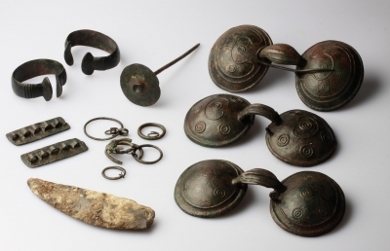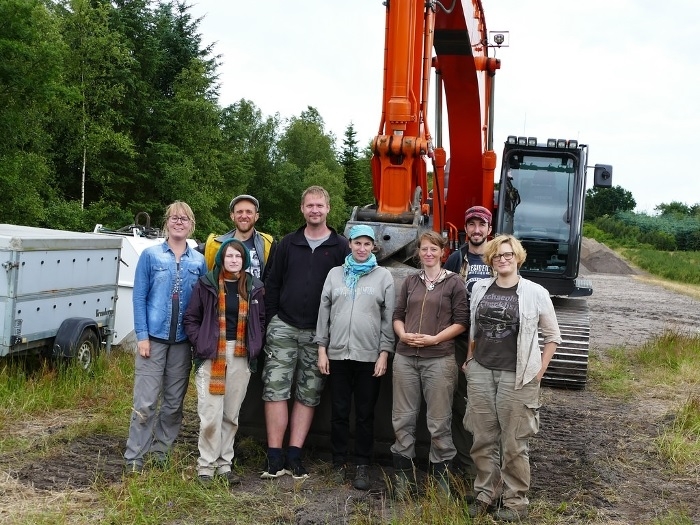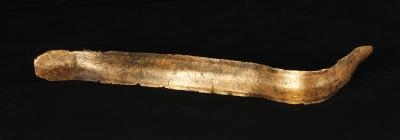Research project
Economies of Destruction
The emergence of metalwork deposition during the Bronze Age in Northwest Europe, c. 2300-1500 BC
- Duration
- 2015 - 2020
- Funding
-
 N.W.O. Innovational Research (Vernieuwingsimpuls) VICI
N.W.O. Innovational Research (Vernieuwingsimpuls) VICI
Research questions:
1.Why was metal deposited in a manner that demonstrates this was guided by specific codes and conventions?
2.Why was metal not deposited in cult places or temples, but in unmarked natural zones?
Abstract

IIn prehistory, objects that were of great value were deliberately destroyed at a large scale and permanently deposited in the landscape. We investigate why people did this and reconstruct how between 2300-1500 BC an entire ‘economy of destruction’ emerged in Northwest Europe.
Problem
The accumulation of wealth is generally regarded as a universal way of achieving power and prestige, but how can a society function when its members systematically destroy wealth? This happened in Bronze Age Europe, when communities deliberately deposited prestigious metalwork on a massive scale.

Approach
We want to understand this puzzling practice by reconstructing how it emerged and developed in Northwest Europe from 2300-1500 BC in a multidisciplinary project combining archaeology with economic anthropology, craft theory, and methods from network science and geographical studies.
Scientific relevance
Our approach is innovative because of its focus on practices that we explore as multi-scalar networks, comparing practices from all contexts. We do not see objects solely as symbols or indices of prestige. Rather, we think objects were perceived as meaningful for permanent deposition because of what people did with them – ranging from production to final deposition. By its European approach, the project overcomes language boundaries and national research traditions.

Project structure
Marieke Visser, Leah Powell and Sabrina Autenrieth will study the rise of depositional practices in three key regions in the Channel/North Sea Nexus and the Middle Rhine. Maikel Kuijpers will research how craft and visual appearance of objects influenced selections of objects for depositions. Catalin Popa and Marieke Doorenbosch will explain the orderings of depositions in the Bronze Age landscape, using Geographical Information System computer models and vegetation reconstructions. David Fontijn and the network specialist David Schoch will investigate how a supra-regional destructive economy emerged and bring this back to the question of how a society with such destructive practices operates. Was what happened in the Bronze Age historically unique, or is object destruction a universal social strategy?
Societal relevance
The project will add a thought-provoking dimension to objects that have a great appeal to the general public. It will yield models that can be used to predict the location of still-undiscovered depositions and to protect these as heritage. This is essential to stop the alarming rate of illegal looting of metalwork from deposition landscapes.
Partners
Local: European Prehistory (prof. dr H.Fokkens), anthropology (prof. dr R.Corbey), archaeobotany laboratory (prof. dr C.Bakels), artifact laboratory (prof. dr A.Van Gijn). Our heritage advisors are dr M. van den Dries and prof. dr J.Kolen
National: Technical University Delft (metallurgy: prof. dr ir J.Sietsma)
International advisors on Bronze Age regions: prof. dr M.L. Sørensen, dr Ch.Evans (Cambridge), prof. dr S.Wirth (Bourgogne), dr C.Marcigny (Rennes), prof. dr J.Müller (Kiel), prof. dr H. Vandkilde (Arhus).
International advisors on metalwork deposition in Europe: prof dr S. Hansen (Berlin, DAI), prof. dr R. Bradley (Reading/Oxford)
Network Science: prof. dr U.Brandes (Konstanz).
Anthropology: prof. dr H.P. Hahn (Frankfurt/Main)
